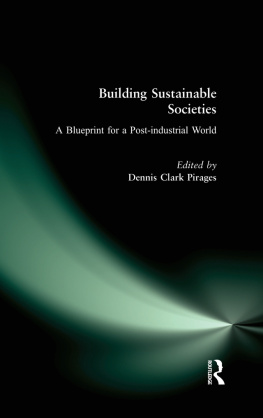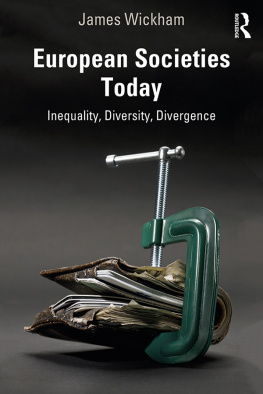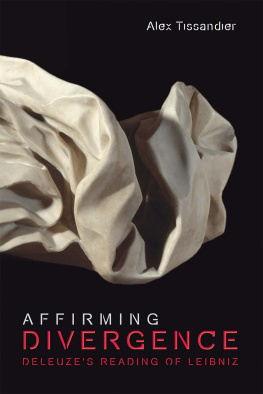First published 1998 by Westview Press
Published 2019 by Routledge
52 Vanderbilt Avenue, New York, NY 10017
2 Park Square, Milton Park, Abingdon, Oxon OX14 4RN
Routledge is an imprint of the Taylor & Francis Group, an informa business
Copyright 1998 Taylor & Francis
All rights reserved. No part of this book may be reprinted or reproduced or utilised in any form or by any electronic, mechanical, or other means, now known or hereafter invented, including photocopying and recording, or in any information storage or retrieval system, without permission in writing from the publishers.
Notice:
Product or corporate names may be trademarks or registered trademarks, and are used only for identification and explanation without intent to infringe.~
Library of Congress Cataloging-in-Publication Data
Inkeles, Alex, 1920
One world emerging? : convergence and divergence in industrial
societies / Alex Inkeles.
p. cm.
Includes bibliographical references and index.
1. Social history1945 .2. Social change.3. Social
institutions. I. Title.
HN17.5.I528 1998
306.09dc21
97-46434
CIP
ISBN 13: 978-0-367-28192-2 (hbk)
Massive forces driving social change are surging through the world, increasingly reaching into what had been the most inaccessible and remote corners of the globe. Since the mid-nineteenth century, industrial production, technologically sophisticated agriculture, popular education, mass media and electronic communication, high-speed transportation, and science-based research and development have transformed Europe and most of North America. Even as Russia turned to socialism and Communist rule after World War I it nevertheless built into its system all the elements in this list. In Asia Japan led the way in the first half of the twentieth century, but in the second half many others joined the mainstream while in some respects Japan moved to the position of world leader.
Other nations of Asia, notably India and China, have only in modest degree joined this world revolution, and still others, such as Burma and Vietnam, are, for the present at least, operating in a largely premodern mode. This is also the case for many parts of South America, and even more so for most of Africa. One of the great unknowns is whether or not those nations now outside the mainstream, particularly in Africa, can be brought within it as effective members of the modern world community. Making that possible is surely one of the greatest challenges facing humanity in the twenty-first century.
To give structure and coherence to the enormously complex process that constitutes the modern world revolution, I emphasize the theme of convergence, both in institutional structures and in popular attitudes and values.
Although its elaborations and ramifications can become extraordinarily complex, the basic idea is very simple. We start with the assumption that some human needs and aspirations are more or less universal. At the individual level these include health, material well-being and the means to achieve it, some degree of personal security, reasonably stable and satisfying patterns of interpersonal relations, and some form of community. At the national level they include various forms and degree of power, autonomy, prestige, and territorial integrity.
In the modern world most governments and the vast majority of individuals have apparently concluded that most of these goals are more fully and effectively attained to the degree that one adopts and develops a standard set of institutions: factories, schools, mass media, airlines, universities, hospitals, banks, and perhaps most important of all, institutes and science centers for generating new basic knowledge. Related processes, such as the decrease in family size and the aging of the population in industrial nations, stimulate the adoption of other institutions such as social security and oldage pension schemes. The increasing proportion of women working outside the home, and related developments, lead to the elaboration of service institutions such as fast food sources and commercial laundries. And so it goes.
All this means that increasingly all industrial nations, and others aspiring to become industrial, come to have the same array of institutional patterns, toward which array they converge . Some get it all, some understand or can develop only part of the array. Some utilize these institutions well, some less well, and some very poorly indeed. There is much room for variation, and seeking the reasons for it will keep large numbers of social scientists and commentators well occupied for many years to come. But such variation does not deny the main effect of a general movement toward a common set of institutions. Moreover, the test of effectiveness in reaching stated goals, and the competition with others joined in the same interlocking international system, together create additional pressure to refine and reorganize particular institutions, and even the whole array, in accordance with principles that come more and more to be widely accepted, thus giving further impetus to the process of convergence in institutional structures across national boundaries.
The second realm of convergence involves the movement of national populations away from whatever had been their diverse indigenous cultural patterns and toward the adoption of attitudes, values, and modes of daily behavior that constitute the elements of a more or less common world culture. In this process almost every aspect of life is influenced, and in many instances profoundly changed. The realms affected range from the most personal and intimate, as in how one finds a spouse and the role of love in that search, to the more abstract, as in conceptions of what makes for happiness and a good life. In between these poles a host of attitudes, values, and ways of living are shaped in increasingly comparable ways as styles of clothing and modes of dress, tastes in popular music, and even preferences in food come to be internationalized and relatively homogenized. At the core of all these changes, in many ways the key element in the whole process, is increasing individualism, the creation for each person of a distinctive identity separate from that of clan, family, and even nation. But this freedom from communal and collective control and dominance is not attained without its costs, expressed in part in painful isolation and in part in the loss of social control over behavior. These outcomes in turn stimulate both individual and community efforts not only to compensate for lost social values but also to stop or even to reverse the process of social change.
The forces that move people to these new uniformities are numerous and their action and interaction complex. Whole schools of sociological research are dedicated to advancing the claims of one source and mode of influence over the others. Broadly speaking, they may be divided into two sets. One stresses the importance of forces external to any nation that spread, perhaps even force, their influence in many places and consciously manipulate the lives of many peoples. The other emphasizes processes internal to each population as it adjusts to new institutions the experience of which spontaneously encourages certain modes of response similar to those of the populations in other nations confronted by essentially the same conditions of life.








